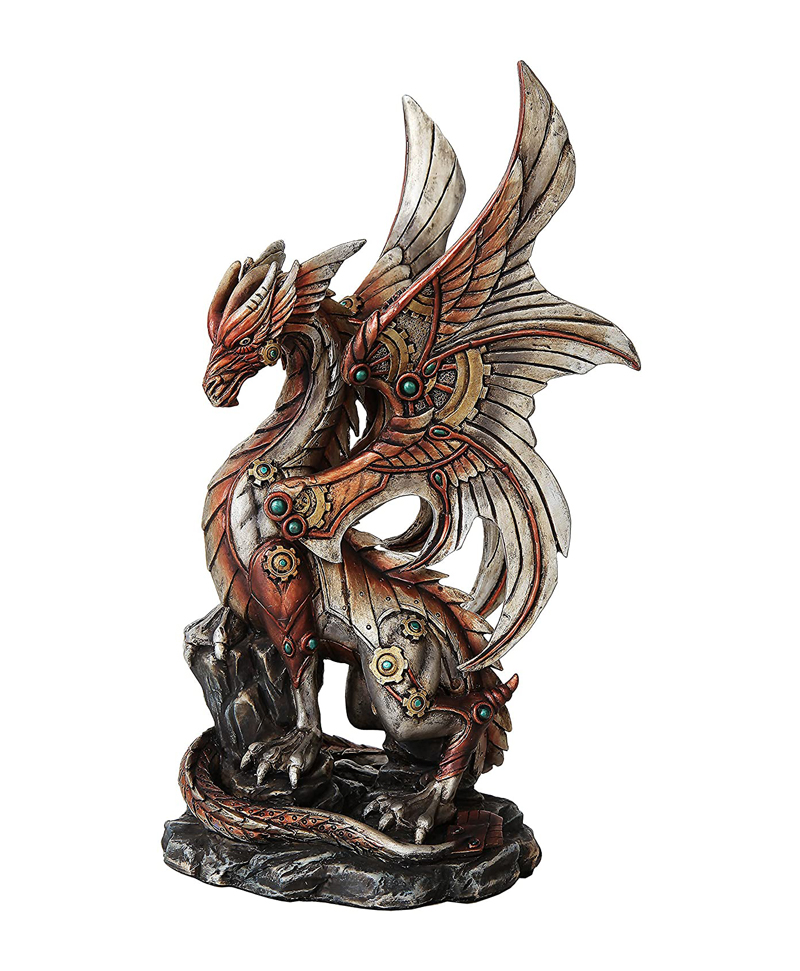Steampunk Inspired Mechanical Dragon Statue
This gorgeous Steampunk Dragon Statue has finest details and highest quality, truly remarkable. The gears on the statue are sculpted and painted on, they do not move. Made of designer composite resin, hand painted and polished individually. Eragon is an impressive cyborg dragon, the ruler of Patagonia. His skin is made of impenetrable Heliax metal and he runs by fire, gearwork and steampunk nuclear ion technology. Answering to the Council Of Life, his role in this world is to rule and protect the citizens from alien invasion. Draconic creatures appear in virtually all cultures around the globe. Nonetheless, scholars dispute where the idea of a dragon originates from and a wide variety of hypotheses have been proposed. In his book An Instinct for Dragons (2000), anthropologist David E. Jones suggests a hypothesis that humans, like monkeys, have inherited instinctive reactions to snakes, large cats, and birds of prey. He cites a study which found that approximately 39 people in a hundred are afraid of snakes and notes that fear of snakes is especially prominent in children, even in areas where snakes are rare. The earliest attested dragons all resemble snakes or have snakelike attributes.
Jones therefore concludes that dragons appear in nearly all cultures because humans have an innate fear of snakes and other animals that were major predators of humans’ primate ancestors. Dragons are usually said to reside in “dank caves, deep pools, wild mountain reaches, sea bottoms, haunted forests“, all places which would have been fraught with danger for early human ancestors. In her book The First Fossil Hunters: Dinosaurs, Mammoths, and Myth in Greek and Roman Times (2000), Adrienne Mayor argues that some stories of dragons may have been inspired by ancient discoveries of fossils belonging to dinosaurs and other prehistoric animals. She argues that the dragon lore of northern India may have been inspired by “observations of oversized, extraordinary bones in the fossilbeds of the Siwalik Hills below the Himalayas” and that ancient Greek artistic depictions of the Monster of Troy may have been influenced by fossils of Samotherium, an extinct species of giraffe whose fossils are common in the Mediterranean region. In China, a region where fossils of large prehistoric animals are common, these remains are frequently identified as “dragon bones” and are commonly used in traditional Chinese medicine.
Mayor, however, is careful to point out that not all stories of dragons and giants are inspired by fossils and notes that Scandinavia has many stories of dragons and sea monsters, but has long “been considered barren of large fossils”. In one of her later books, she states that “Many dragon images around the world were based on folk knowledge or exaggerations of living reptiles, such as Komodo dragons, Gila monsters, iguanas, alligators, or, in California, alligator lizards, though this still fails to account for the Scandinavian legends, as no such animals (historical or otherwise) have ever been found in this region”. Robert Blust in The Origin Of Dragons (2000) argues that, like many other creations of traditional cultures, dragons are largely explicable as products of a convergence of rational pre-scientific speculation about the world of real events. In this case, the event is the natural mechanism governing rainfall and drought, with particular attention paid to the phenomenon of the rainbow. Steampunk Inspired Mechanical Dragon Statue sizes: 12.7 inches / 32 cm x 7.8 inches / 20 cm x 6.4 inches / 16 cm.
Steampunk Dragon Statue on Amazon.
Steampunk Dragon Statue on eBay.
Dragons Statues and Steampunk Statues.




You must be logged in to post a comment.